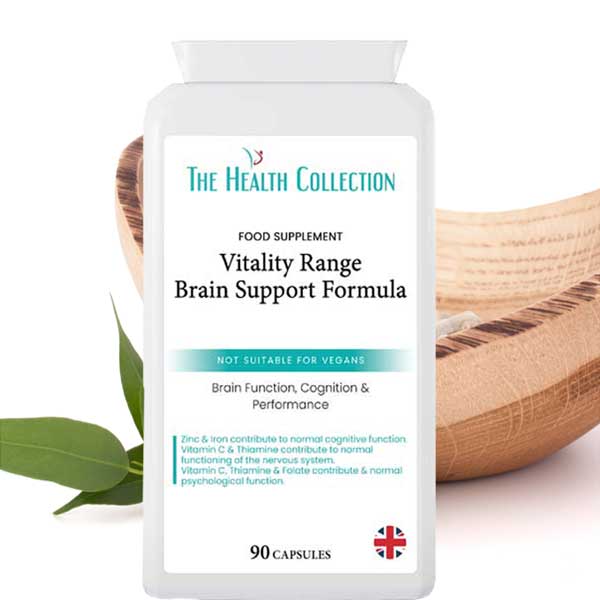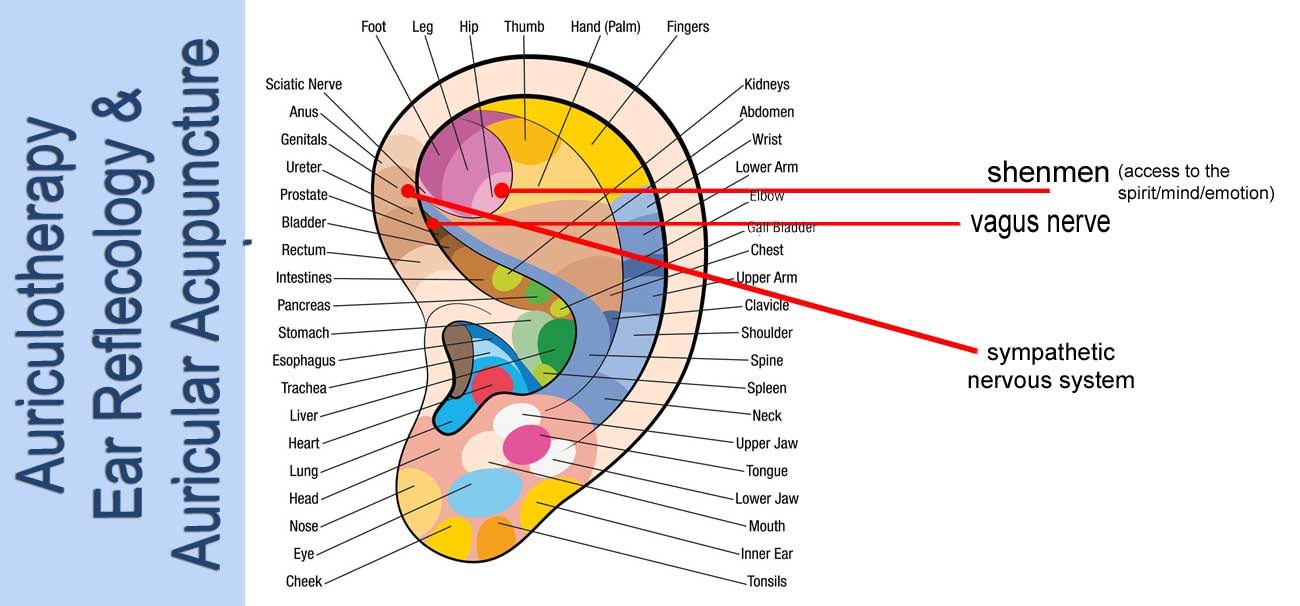What Is The Vagus Nerve?
The vagus nerve is one of the 12 cranial nerves in the body and is responsible for regulating many of your body functions including heart rate, breathing and digestion. These cranial nerves come in pairs and they link the brain with the other parts of the body. Some of the cranial nerves send sensory information to the brain such as information about smells, sights, tastes and sounds (known as sensory functions). Other cranial nerves control muscle movement and gland functions (known as the motor functions). Most cranial nerves have either sensory functions or motor functions but the vagus nerve has both and is one of the reasons it is often referred to as the superhighway of the nervous system.

The nervous system consists of 2 parts, the sympathetic and parasympathetic systems.
Your sympathetic nervous side is responsible for increased alertness, energy at the ready, blood pressure, heart rate and breathing rate. The sympathetic system controls your ‘fight, flight, freeze’ function.
Your parasympathetic nervous system is calmer and is greatly influenced by your vagus nerve, it is the ‘rest and digest’ side. Operating far below the level of your conscious mind, the vagus nerve is vital in decreasing blood pressure, heart rate, restful breathing, mental relaxation, good digestion, balanced bladder and bowel and sexual functions.
What Does The Vagus Nerve Do?
The vagus nerve, aka the pneumogastric nerve, is responsible the regulating the functions of a number of internal organs including;
- heart rate
- cardiovascular activity
- breathing
- digestion
- reflex actions (coughing, sneezing, vomiting, swallowing).
Vagus Nerve Problems
Given it’s prominence in the proper functioning of the body, any irregularities in the vagal nerve system can cause a wide variety of symptoms including;
- Heart rate changes
- Blood pressure changes
- Abdominal pain
- Gastric reflux
- Difficulty swallowing
- Speech difficulties
- Hoarseness
- Loss of appetite
- Weight loss
- Nausea or vomiting
- Dizziness or fainting.
Vagal Tone And Inflammation
Vagal tone refers to the strength of the signals transmitted by the vagus nerve and recent research has linked low vagal tone to chronic inflammation. One of the vagus nerve’s main jobs is to reset the immune system after a stress response and it does this by switching off the production of inflammatory proteins known as TNFs (tumour necrosis factor). If you have a low vagal tone then this immune system regulation becomes impaired and leads to excessive inflammation. Some evidence suggests that vagal stimulation to increase vagal tone can help minimise inflammation and therefore can be beneficial in the treatment of rheumatoid arthritis and other inflammatory conditions. A 2016 study suggests that Vagus Nerve Stimulation Inhibits Cytokine Production And Attenuates Disease Severity In Rheumatoid Arthritis.
Vagus Nerve Stimulation
Vagus nerve stimulation is a medical treatment that involves using an electrical stimulator, which is connected to the left vagus nerve in the neck, to be inserted into the body. This stimulator sends mild electrical stimulations through the nerve and is usually used in the treatment of epilepsy and similar conditions.
One of the main functions of the vagus nerve is to control your body’s ‘rest and digest’ function, allowing your body to relax and conserve energy to be used later in general bodily functions such as bladder control and digestion. A well toned vagus nerve allows you to relax when needed and to effectively counteract the ‘fight or flight’ response during stressful periods, meaning that your body and mind are better able to deal with stress on an ongoing basis. This allows your entire being to be in perfect harmony and balance and can enhance mood, manage pain and strengthen general resilience and stress response.
- Cryotherapy or ice baths
- Deep slow breathing exercises
- Meditation
- Reflexology or massage
- Singing (stimulates vocal cords which stimulate vagus nerve)
- Yoga or other energy practices.
Cryotherapy / Ice Baths / Cold Water Immersion
Exposure to cold is one of the most effective ways to stimulate your vagus nerve. Your body’s natural response to sudden cold is to use your breathing to calm down, jumping you from your sympathetic to parasympathetic nervous system in approximately 45-70 seconds.
As soon as you plunge into cold water, you get a ‘shock response’, adrenaline courses through your body and your heart speeds up, your blood pressure raises and glucose and fats are released into your bloodstream. This response is your body’s way of preparing you for a sudden need to escape a stressful situation. The classic ‘fight or flight’ response.
Adrenaline is quickly followed by a rush of endorphins in the brain, providing pain relief and a sense of euphoria. Norepinephrine is released into your bloodstream giving you increased focus, attention and concentration. This hormone is also a power neurotransmitter and has anti inflammatory effects and can help alleviate chronic stress conditions, depression and anxiety. Inflammation is a natural healthy response to stress but, in normal conditions, it should dissipate quickly once the emergency is over. Modern life seems to be designed to keep us in a high stress mode meaning that we are constantly at a higher risk of chronic inflammation and inflammatory disorders.
Cold water plunges allows your body to naturally adapt to stress, in a controlled way, making your system less reactive and more resilient to future shocks. Cold water resets your sympathetic nervous system and allows it to become used to stress shocks meaning that your body will be able to deal with future stress (of any kind) in the future. This will lead to reduced inflammation as well as reducing stress related anxiety, depression and other disorders.
After a few minutes, when your body adjusts to the cold, sympathetic nerve activity decreases while parasympathetic nerve activity increases. Your heart rate slows, your breathing eases, your mind and body relax, you are feeling the effects of the beneficial hormones racing through your brain and body, every organ and cell in your body is getting a boost. Allow your body to relax into the water, breathe deeply and evenly and let the water do it’s job.
Repeated cold exposures reduces your body’s defensive stress response, prolonging your need to ‘fight or flight’. Over the longer term, you will increase your body and mind’s ability to calmly deal with stress of any kind. Your levels of anxiety will be lowered, your blood pressure and heart rate will be more relaxed, your general mood will benefit and overall inflammation will decrease. Ice bath or cold water plunges have an overall benefit on every aspect of your wellbeing.
Slow Deep Breathing
Breathing is key to good health. Every time you breathe in, you breathe oxygen rich air into your lungs, you heart beats faster, carrying the oxygen around your body. Every time you breathe out, your heart slows and you release toxins from your body. This variability in heart rate is controlled by your vagus nerve, becoming active on breathing out but suppressed when breathing in. The bigger the variability in your heart rate between breathing in and breathing out, the higher your vagal tone. You can deliberately increase your vagal tone by breathing alone.
When breathing out, the vagus nerve causes acetylcholine (a neurotransmitter / chemical messenger) to be released, causing your blood vessels to dilate, lowering blood pressure and slowing heart rate. It is during these exhalations that vagal tone is developed hence the importance of long exhalations in many yogic and meditation practices.


Vagal Breath Work
Every time you breathe in, your heart beats faster in order to speed the flow of oxygenated blood around your body. Breathe out and your heart rate slows. This variability is one of many things regulated by the vagal nerve, which is active when you breathe out but suppressed when you breathe in, so the bigger your difference in heart rate when breathing in and out, the higher your vagal tone.
Ideally spend 5-25 minutes a day practicing vagal breathing. To begin sit comfortably and make sure that you are warm enough and not sitting in a draught. Also make sure that your hands are resting comfortably.
- Close your eyes and continue to breathe normally. Observe your natural breathing
- Inhale through your nose, pulling your breath down into your belly, allowing your belly to expand
- Exhale slowly out through your mouth, allowing your belly to relax
- Inhale deeply, expanding your belly and let your lower belly relax back towards your spine on exhaling
- Continue breathing in this manner until you feel fully relaxed
- Now on inhaling, pull your breath towards the back of your throat and up into your sinus cavity
- On exhalation, contract your throat muscles, making a soft ‘haaa’ sound as you exhale, the same sound made when using your breath to fog a window
- As you become more experienced with this technique, try this exhalation while keeping your mouth closed
- This exhalation sound tones the vagus nerve with every breath
- As you breathe, keep your inhalations at the same length but try to lengthen your exhalations so that they are longer than your inhalations.
The next step;
- Gently Inhale and hold your breath for 3-4 seconds, allowing the air to remain in your lungs
- Slowly exhale making the ‘haaa’ sound and allowing your body to fully relax as you do so
- When you get to the bottom of your exhalation continue the exhalation for a couple of seconds more
- Continue this breathing pattern until you feel comfortable with it
- Then return to your normal breathing pattern for a few minutes more before opening your eyes
This vagal breathing practice will effectively tone your vagus nerve while also allowing your body to deeply relax. In everyday life it will allow you to become more focused, lighter, happier and can even help reduce pain.
Although you can practice vagal breathing while lying down, it is best done when sitting.
When you practice these breathing exercises, it is important that you listen to your body. If at any point, you start to feel uneasy or stressed, if your mouth becomes dry or you feel lightheaded, then you may be pushing too hard and are activating your stress response. Best to stop and relax and try again later or another day.
When you start to stimulate your vagus nerve you may feel a little drowsy and possibly have a little increased saliva in your mouth. As the blood moves around your body, you may also notice that your hand and feet feel a little warmer. These are perfectly normal reactions when starting this practice.
As you go about your day, bring your attention to your breathing, maybe taking a minute or two out here and there to do vagal breathing. Becoming familiar with this technique will place you in good stead for those stressful days that seem to come so often in this modern world. In the longer term, taking a bit of time for yourself, for your breathing, will benefit your overall resilience and health.


Nutrients To Support Your Vagus Nerve
Nutrition plays an important part in your vagus nerve health. Supplements that support your vagal nerve health include;
Choline: Vital in making aceylcholine, our main body neurotransmitter. Choline, although classed as neither a vitamin or a mineral, is generally grouped with the B vitamins and is a nutrient essential to our wellbeing. Food sources of choline include red meat, chicken, fish, eggs, and sunflower seeds. Animal sources are best as plant sources are poorly absorbed by our bodies. Choline is a main ingredient in our Brain Support Formula.
Magnesium: Supports the function of the central nervous system as well as contributing towards over 300 other body functions. Playing a major role in nerve transmission and neuromuscular transmission, Magnesium induces a relaxation response allowing us to better control our stress response and cortisol levels. See Magnesium plus Vitamin B6.


Omega 3 Fatty Acids: Essential for the proper functioning of the nervous system, fatty acids contribute to the insulation round our nerve cells, protecting them from damage and ensuring proper nerve signal transmission. Food sources include fish (cold water fatty fish, salmon, maceral, herring, sardines), nuts and seeds (walnuts, flaxseed, chia seed) and plant oils (flaxseed, soyabean). You can also take a supplement such as Magnesium & Vitamin B6. Clean water Antartic Krill Oil Omega 3, EPA & DHA or Vegan Omega 3 EPA & DHA softgels.
Ashwagandha: A natural adaptogen helping our nervous system to withstand stress and prevent adrenal fatigue. Naturally rejuvenating to the nervous system, Ashwagandha supports brain cell function and contributes towards memory and cognition. Try our Natural Ashwagandha KSM-66.
L-Theanine: An amino acid naturally occurring in tea leaves (matcha & green tea), L-Theanine promotes relaxation and helps increase cognitive function. It can increase serotonin (our happy hormone), dopamine (a neurotransmitter) and GABA (inhibitory neurotransmitter that prevents excess neuronal excitability). All the above hormones are necessary in keeping our mood level, preventing excess stress or anxiety and in regulating our wake – sleep cycle and are found in our Brain Support Formula supplement.
Vagal Stimulation Meditation
Meditation to stimulate your vagus nerve is very similar to vagal breath work. Both meditation and breathing involve detaching yourself from the outer surrounding world, becoming more self aware, going deep inside yourself and regulating your breathing. Any meditation will help tone your vagus nerve although Tummo meditation seems to be popular for this.
Tummo Meditation Breathing
Tummo meditation originates from ancient Tibet and is also known as ‘psychic heat‘. It is a visualisation and breathing exercise developed by monks who meditated in the bitter cold. It allowed them to get in touch with their inner fire and remain warm during hours-long outdoor meditations in near freezing temperatures. Tummo allows the practitioner to go into a very deep inner meditative state.
Tummo meditation uses intense visualisation to generate inner warmth by activating the sympathetic nervous system. Heart rate and alertness increase and non essential body metabolism functions shut down thereby increasing blood supply to the extremities.


Massage & Reflexology
The ear is the only place on the body that the vagus nerve comes to the surface and ear reflexology or needling on this point can be very effective in toning/stimulating the vagus nerve. You can even massage this ear point yourself and receive a daily benefit from the stimulation. Two other points that can be used in conjunction with the vagus point are the sympathetic nervous system point and shenmen (divine gate in traditional Chinese medicine). These three points, when massaged/needled regularly can create a very subtle yet powerful effect.
In the case of general body massage or foot reflexology, both are highly beneficial. Both therapies allow your body to enter a state of deep relaxation akin to meditation and help tone your vagal system.
Can Singing Tone Your Vagus Nerve?
The vagus nerve is connected to your vocal cords via the muscles at the back of your throat. As well as promoting healing through freqency, singing activates the vocal cords and massages the vagus nerve through movement. Singing / humming in a pleasing vibration resonates with your vagus nerve and triggers a parasympathetic response that soothes your body into a calmer state. By soothing your physical body with vibration, you also soothe your mind and spirit.
Sound baths and sound bowl healing can also prove highly beneficial in stimulating your vagal nerve as they resonate at specific frequencies beneficial to the vagus nerve and vagal tone.
Yoga For Vagal Tone
Yoga and yogic breathing directly stimulate the vagus nerve thereby increasing vagal tone, resulting in better mood, improved cognition, focus and concentration, lower heart rate and blood pressure and overall autonomic regulation (involuntary physiologic functions such as heart rate, blood pressure, breathing, digestion).


The Bottom Line
The health of your vagus nerve can be measured by it’s tone. The higher the tone, the better the condition of your vagus nerve and your general overall health. A high vagal tone typically indicates that your autonomic nervous system is dealing with stress appropriately and is not placing any extra load on your body. A low vagal tone indicates that one is stuck in a hyper sympathetic nervous system event, symptoms can include clammy skin, sweaty palms, shallow breathing, rapid breathing, rapid or rising heartbeat, general restlessness, inability to sit/stand still. Ongoing low vagus tone can lead to illness, depression, withdrawal from places and/or people, anxiety and emotionally deficiency. Whereas a healthy vagal tone leads to balanced emotional health, better social connections, good physical and mental wellbeing and an overall positive attitude.
Take your health and wellbeing into your own hands and practice vagal nerve stimulation and toning as often as you can.
If you think this article will prove helpful to someone please feel free to share. In fact, we would love if you could share it on your social media, it would really help our ranking 🙂
If you have any queries please don’t hesitate to contact us or leave a comment below.


Thank you for reading our article and we hope you enjoyed reading it as much as we enjoyed writing it. As always, we ask that you read our Disclaimer and if you would like to keep up to date on more future articles and news, please subscribe to our newsletter below.


